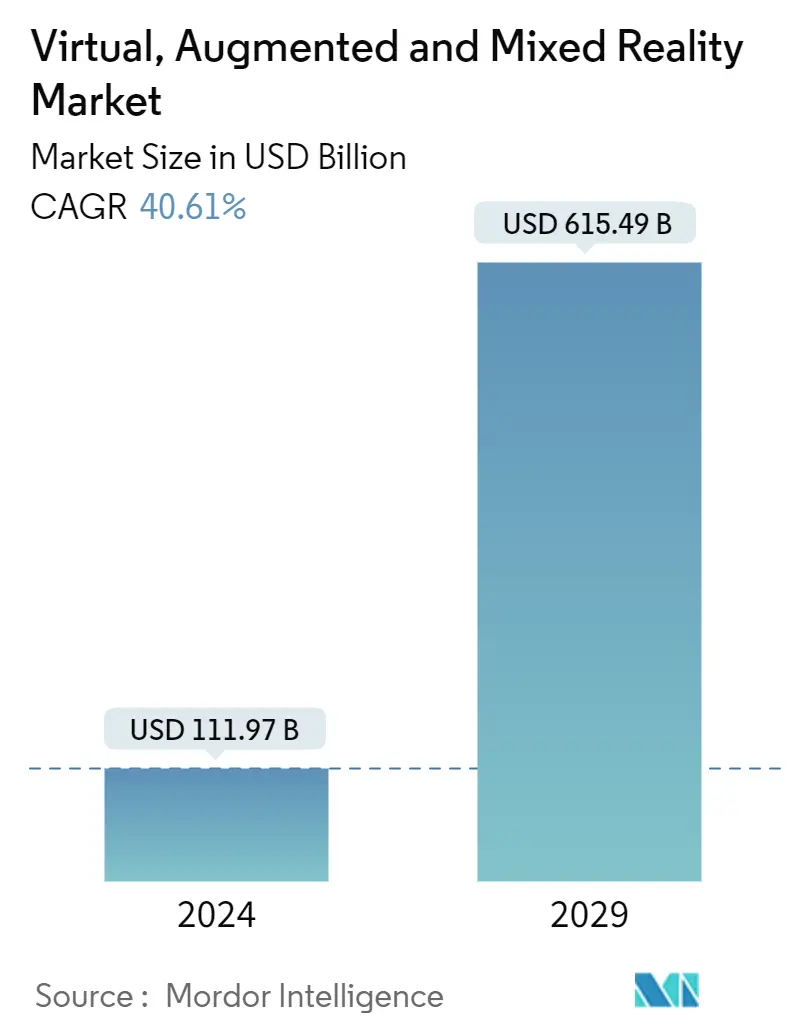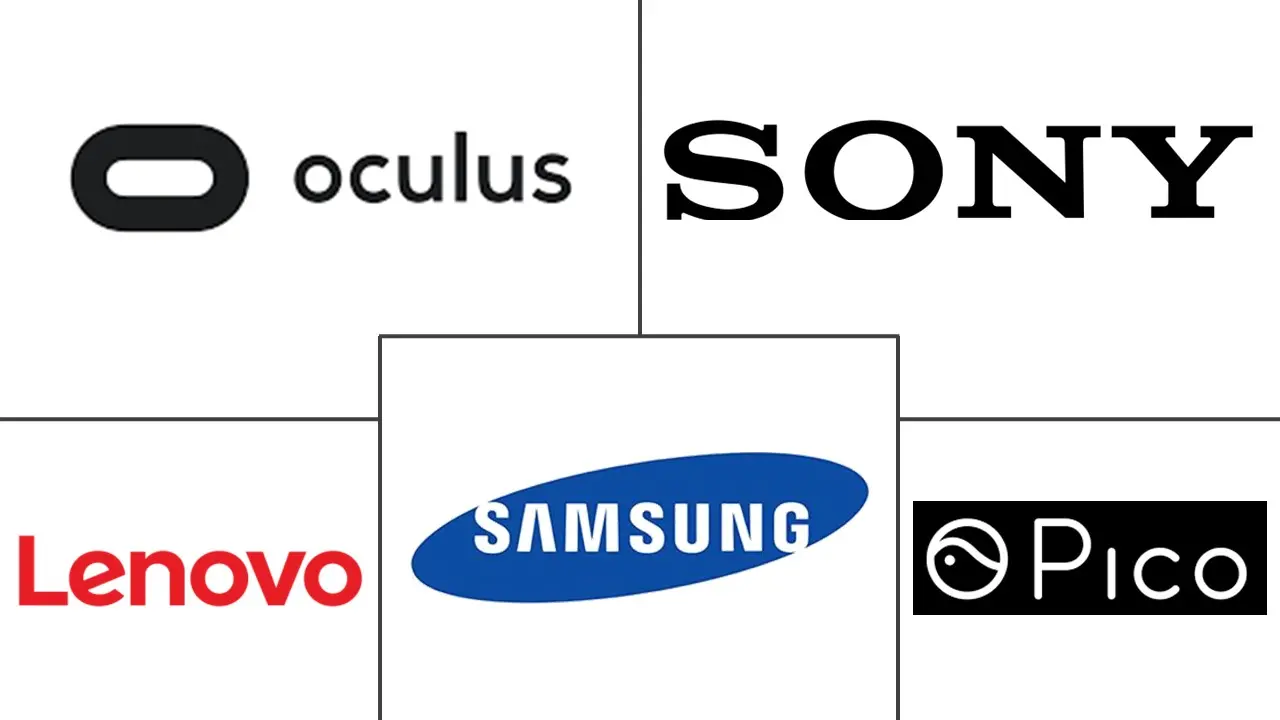Market Size of Virtual, Augmented, And Mixed Reality Industry

| Study Period | 2019 - 2029 |
| Market Size (2024) | USD 111.97 Billion |
| Market Size (2029) | USD 615.49 Billion |
| CAGR (2024 - 2029) | 40.61 % |
| Fastest Growing Market | Asia Pacific |
| Largest Market | North America |
| Market Concentration | Low |
Major Players
*Disclaimer: Major Players sorted in no particular order |
Virtual, Augmented, and Mixed Reality Market Analysis
The Virtual, Augmented And Mixed Reality Market size is estimated at USD 111.97 billion in 2024, and is expected to reach USD 615.49 billion by 2029, growing at a CAGR of 40.61% during the forecast period (2024-2029).
- Virtual reality is the utilization of computer technology primarily aimed at generating a simulated environment. In contrast to the conventional user interface, VR enables users to fully engage in an immersive experience rather than merely observing a monitor screen. This technology has undoubtedly revolutionized various aspects globally by providing a multi-sensory simulation encompassing aspects like vision, touch, hearing, and smell.
- In contrast, augmented reality is a captivating experience that enriches the real world by incorporating computer-generated perceptual information. Augmented reality seamlessly incorporates digital content into our surroundings and objects by utilizing software, apps, and hardware like AR glasses.
- Augmented reality (AR) has experienced remarkable growth due to the widespread utilization of this technology in commercial settings. It is anticipated to hold significant importance in the upcoming years, considering the substantial investments made in innovation and adoption by prominent technology market leaders like Apple, Google, Facebook, Microsoft, and Amazon. The expanding presence of smartphones and the increasing integration of AR in mobile gaming are key drivers of this market, leading to the development of more solutions by major vendors in this segment.
- Using mixed reality may enhance the interactivity of classroom education, as it empowers teachers to present virtual examples of concepts and incorporate gaming elements to supplement textbooks. Consequently, this innovative approach facilitates accelerated learning and improved retention of information for students.
- It is worth acknowledging that an increasing number of students face challenges in maintaining focus and concentration during their educational journey, particularly at universities and colleges. They may also encounter various mental health issues, such as depression and anxiety.
- Virtual reality is emerging as a revolutionary technology that may notably impact various end-user industries. The acceptance of the technology is witnessing continuous growth, leading to significant expansion in the number of use cases. Virtual reality technology also offers several advantages that are changing the dynamics of businesses and commercial enterprises used to operate earlier.
- For instance, the technology is being used in the retail industry to enhance consumer experience. Before purchasing, they may use it to check the product in a virtual environment. By using the technology, businesses across various end-user industries may develop robust marketing campaigns to attract the attention of more customers. It also helps them offer remote maintenance and support by providing the procedures in a virtual environment.
- Training and skill development are among the major sectors wherein the demand for virtual reality technology is anticipated to witness substantial growth primarily due to factors such as the convenience the technology adds to the process. Furthermore, it also helps minimize the overall training cost while making the process safer than traditional methods. For instance, to train employees to work in hazardous environments, organizations may use a simulated virtual environment rather than sending the employee to the actual site.
- Although the AR/VR/MR market is finding an enhanced footprint across various industries, the technological and cost limitations remain relevant in the market as these are emerging technologies and are yet to achieve standardization and mass acceptance. Furthermore, these technologies are complex and require a skilled workforce for further development. Hence, the lack of sufficient availability of a skilled workforce is another major factor challenging the market’s growth.
Virtual, Augmented, and Mixed Reality Industry Segmentation
The study includes detailed examinations of hardware and software segments within virtual reality (VR), augmented reality (AR), and mixed reality (MR), as well as an exploration of end-user industries. Virtual reality (VR) utilizes specialized hardware and software to immerse users in computer-generated environments, often through headsets or sensory devices. Augmented reality (AR) enhances the real-world environment by seamlessly overlaying digital information, commonly experienced through devices like smartphones or AR-specific glasses, onto the user's physical surroundings. Mixed reality (MR) combines elements of both VR and AR, allowing users to interact with digital content while remaining aware of their physical surroundings.
Virtual reality is segmented by type (hardware (tethered HMD, standalone HMD, and screenless viewer) and software), end-user vertical (gaming, media and entertainment, retail, healthcare, military and defense, real estate, and education), geography (North America, Europe, Asia Pacific, Latin America, and the Middle East & Africa), augmented reality is segmented by type (hardware and software), end-user vertical (gaming, media and entertainment, retail, healthcare, military and defense, and real estate, education), geography (North America, Europe, Asia-Pacific, Latin America, and Middle East & Africa), and mixed reality is segmented by type (hardware and software), end-user vertical (gaming, media and entertainment, retail, healthcare, military and defense, real estate, and education), geography (North America, Europe, Asia-Pacific, Latin America, and Middle East & Africa). The report offers the market size in value terms in USD for all the abovementioned segments.
| By Type | |||||
| |||||
| Software |
| By End-user Vertical | |
| Gaming | |
| Media and Entertainment | |
| Retail | |
| Healthcare | |
| Military and Defense | |
| Real Estate | |
| Education |
| By Geography | |
| North America | |
| Europe | |
| Asia | |
| Australia and New Zealand | |
| Latin America | |
| Middle East and Africa |
Virtual, Augmented, And Mixed Reality Market Size Summary
The virtual, augmented, and mixed reality market is poised for significant expansion, driven by advancements in technology and increasing adoption across various sectors. Virtual reality (VR) offers immersive experiences that are transforming industries such as gaming, retail, and training, by providing multi-sensory simulations that enhance user engagement. Augmented reality (AR) is gaining traction in commercial applications, supported by substantial investments from tech giants and the proliferation of smartphones. Mixed reality (MR) is also emerging as a valuable tool in education, offering interactive learning experiences that improve information retention. Despite the promising growth, the market faces challenges such as technological complexities and the need for a skilled workforce, which could hinder widespread adoption.
The North American region, particularly the United States, is experiencing rapid growth in the VR, AR, and MR markets due to increased technological engagement and the availability of advanced devices. The gaming industry, in particular, is witnessing a surge in demand for VR experiences, driven by improved graphics and immersive gameplay. The affordability and accessibility of VR headsets are contributing to broader adoption, with applications extending to healthcare and enterprise solutions. Major players like Oculus VR, Sony, Samsung, and others are actively investing in product innovation and strategic partnerships to enhance their market presence. As these technologies become more integrated into everyday life, the market is expected to continue its robust growth trajectory.
Virtual, Augmented, And Mixed Reality Market Size - Table of Contents
-
1. MARKET DYNAMICS
-
1.1 Market Drivers
-
1.1.1 Increasing Adoption of AR/VR in Commercial Application
-
1.1.2 Increasing Demand for VR Setup for Training Across Various End-user Segments
-
1.1.3 Technological Advancements, Networking, and Connectivity Improvements
-
-
1.2 Market Challenges/Restraints
-
1.2.1 Health Risks from Using AR/VR Headsets in the Longer Run
-
1.2.2 Development Complexity and High Cost of AR/VR Devices
-
1.2.3 Cybersecurity and Data Privacy Issues
-
-
-
2. MARKET SEGMENTATION
-
2.1 By Type
-
2.1.1 Hardware
-
2.1.1.1 Tethered HMD
-
2.1.1.2 Standalone HMD
-
2.1.1.3 Screenless Viewer
-
-
2.1.2 Software
-
-
2.2 By End-user Vertical
-
2.2.1 Gaming
-
2.2.2 Media and Entertainment
-
2.2.3 Retail
-
2.2.4 Healthcare
-
2.2.5 Military and Defense
-
2.2.6 Real Estate
-
2.2.7 Education
-
-
2.3 By Geography
-
2.3.1 North America
-
2.3.2 Europe
-
2.3.3 Asia
-
2.3.4 Australia and New Zealand
-
2.3.5 Latin America
-
2.3.6 Middle East and Africa
-
-
-
3. AUGMENTED REALITY (AR) MARKET SEGMENTATION
-
3.1 By Type
-
3.1.1 Hardware
-
3.1.2 Software
-
-
3.2 By End-user Vertical
-
3.2.1 Gaming
-
3.2.2 Media and Entertainment
-
3.2.3 Retail
-
3.2.4 Healthcare
-
3.2.5 Military and Defense
-
3.2.6 Real Estate
-
3.2.7 Education
-
-
3.3 By Geography
-
3.3.1 North America
-
3.3.2 Europe
-
3.3.3 Asia
-
3.3.4 Australia and New Zealand
-
3.3.5 Latin America
-
3.3.6 Middle East and Africa
-
-
Virtual, Augmented, And Mixed Reality Market Size FAQs
How big is the Virtual, Augmented, And Mixed Reality Market?
The Virtual, Augmented, And Mixed Reality Market size is expected to reach USD 111.97 billion in 2024 and grow at a CAGR of 40.61% to reach USD 615.49 billion by 2029.
What is the current Virtual, Augmented, And Mixed Reality Market size?
In 2024, the Virtual, Augmented, And Mixed Reality Market size is expected to reach USD 111.97 billion.

